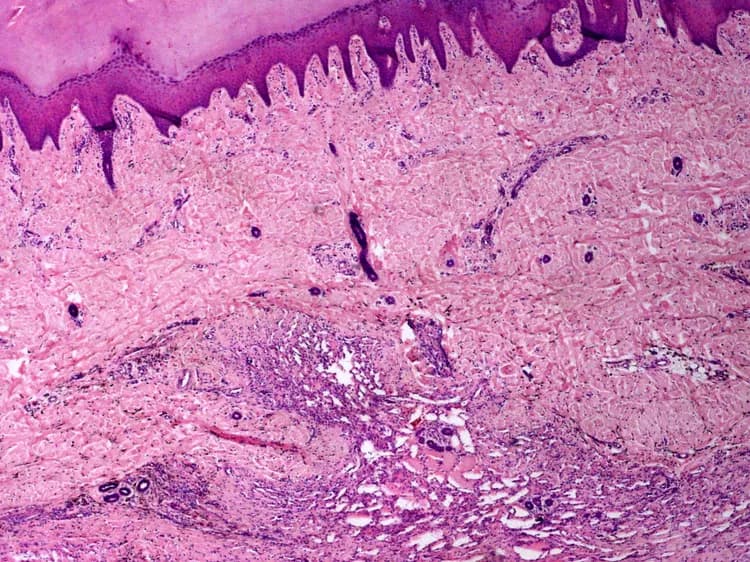What are the other Names for this Condition? (Also known as/Synonyms)
- Angiomatosis (Morphologic Abnormality)
- Vascular Proliferation
What is Angiomatosis? (Definition/Background Information)
- An Angiomatosis is a benign condition, wherein there is a growth of small blood vessels (capillaries) involving multiple tissue types (soft tissues), organs, muscles, and bones. They are known to appear, spread across a large section of the body
- Angiomatosis frequently affects the lower limbs. Other regions where it occurs, are the abdomen, chest, and arms
- They can cause a variety of health concerns, depending on the tumor location and size
Who gets Angiomatosis? (Age and Sex Distribution)
- Angiomatoses usually form during the first twenty years of life, and are definitely noticeable before the mid-adult age of 40 years
- Though it affects both males and females; there is a slight predilection for the female sex
- There is no known ethnic/racial preference
What are the Risk Factors for Angiomatosis? (Predisposing Factors)
Risk factors are currently unknown; but, Angiomatosis are found to be present with the following disorders:
- Bacillary Angiomatosis
- Klippel-Trenaunay-Weber syndrome
- Sturge-Weber syndrome
- Von Hippel-Lindau disease
It is important to note that having a risk factor does not mean that one will get the condition. A risk factor increases ones chances of getting a condition compared to an individual without the risk factors. Some risk factors are more important than others.
Also, not having a risk factor does not mean that an individual will not get the condition. It is always important to discuss the effect of risk factors with your healthcare provider.
What are the Causes of Angiomatosis? (Etiology)
- The exact cause of Angiomatosis occurrence is unknown. It may be caused by genetic factors
- All lesions become evident by/after adulthood; the inception of which is thought to occur, either at the fetal stage, or after birth
- It has been reported that all lesions are manifested before the age of 20 years
What are the Signs and Symptoms of Angiomatosis?
The presentations are based on the location of Angiomatosis. Signs and symptoms include:
- Angiomatosis grows at a slow rate, but are known to alternatively recede and expand in size
- Most common locations are the legs; other locations include the abdomen, chest wall, and hands/arms
- Generally large Angiomatosis cause more explicit signs and symptoms than smaller tumor growths
How is Angiomatosis Diagnosed?
Diagnostic tests vary, based on location of the tumor. Angiomatosis is diagnosed by:
- Physical exam with evaluation of medical history
- CT, MRI scan of affected region
- Biopsy of tissue: Histopathological studies conducted on a biopsy specimen by a pathologist
Many clinical conditions may have similar signs and symptoms. Your healthcare provider may perform additional tests to rule out other clinical conditions to arrive at a definitive diagnosis.
What are the possible Complications of Angiomatosis?
The complications from Angiomatosis could include:
- If Angiomatosis occurs in brain tissues, then headaches, vision problems, difficulty in walking, and frequent falls, may occur
- Recurrence of the tumor after surgery
- Severe pain, depending on the tumor formation location
- Damage to vital nerves, blood vessels, and surrounding structures during surgery
- Side effects from chemotherapy (such as toxicity), radiation therapy: if these methods are employed for the treatment
How is Angiomatosis Treated?
Treatment measures for Angiomatosis include:
- Wide surgical excision of Angiomatosis with removal of the entire lesion is the preferred method. If the tumor is not fully removed, then it might recur
- When the lesion is not at an accessible location, or is unsafe for surgical intervention; other therapy modes may be employed
- Embolization is used to provide temporary relief from the symptoms, and reduce blood loss during a surgical procedure
- Post-operative care is important: Minimum activity level is to be ensured until the surgical wound heals
- Follow-up care with regular screening and check-ups are important
How can Angiomatosis be Prevented?
Current medical research has not established a way of preventing Angiomatosis occurrence.
What is the Prognosis of Angiomatosis? (Outcomes/Resolutions)
- Angiomatoses are benign, but symptomatic; hence, they may require some form of treatment. The treatment method adopted is based on the location of the lesion
- Prognosis is generally excellent when the lesions are small. In such situations, their recurrence risk is also completely avoided
- The probability of recurrence is high at nearly 50% (in some cases), after surgical removal of the tumor
- If Angiomatosis occurs in the brain, then depending on the size and location, the prognosis will vary from excellent to possible death
Additional and Relevant Useful Information for Angiomatosis:
Venous Malformations and Arteriovenous Malformations used to be synonyms of Angiomatosis previously, but have now been redefined.
Related Articles
Test Your Knowledge
Asked by users
Related Centers
Related Specialties
Related Physicians
Related Procedures
Related Resources
Join DoveHubs
and connect with fellow professionals


0 Comments
Please log in to post a comment.